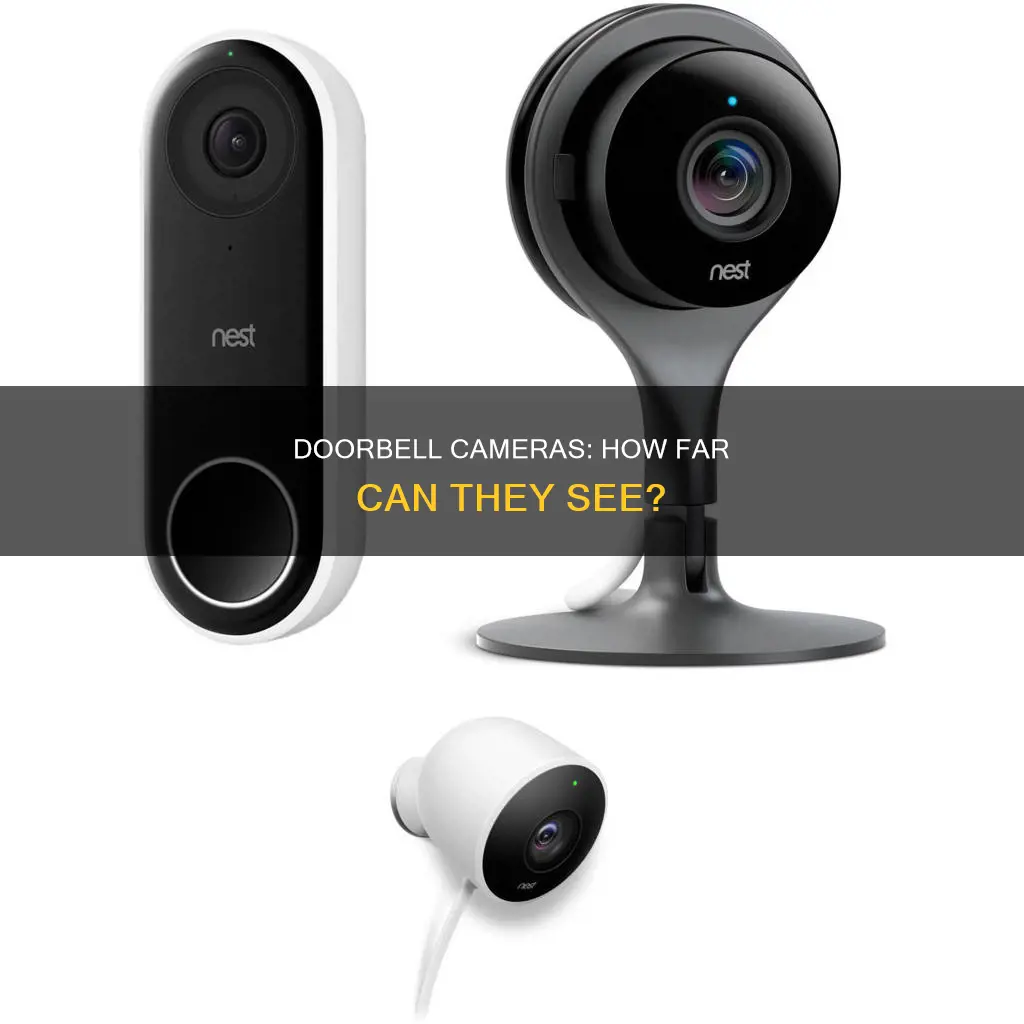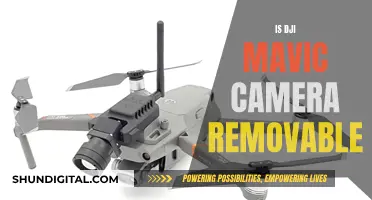
The range of a doorbell camera is an important consideration when investing in home security. Doorbell cameras are designed to see what's happening on your doorstep, recording who or what is there whether or not you're home. The range of a doorbell camera depends on the make and model, with some only covering up to 10 feet, while others can see up to 50 feet. The Nest Hello doorbell camera, for example, can see up to 30 feet away. The Ring Video Doorbell 3 offers a 160-degree horizontal and 84-degree vertical field of vision, with a range of 30 feet during the day and 15 feet at night. Factors such as weather, placement, lighting conditions, and local laws can also impact the distance and field of view of doorbell cameras.
| Characteristics | Values |
|---|---|
| Field of View (FOV) | 90-180 degrees |
| Range | 5-50 feet |
| Motion Detection Distance | 5-30 feet |
| Placement | 1.2 meters above the ground for Ring cameras |
| Sight Distance | 10-15 feet |
| Night Vision | Yes, most doorbell cameras have night vision |
What You'll Learn

The Nest Hello doorbell camera can see up to 30 feet away
The Nest Hello doorbell camera is a great way to monitor your front door and keep an eye on things outside your home. With a range of up to 30 feet, it offers a wide field of view to capture the area around your doorstep. Here are some key advantages and considerations regarding the Nest Hello doorbell camera's range:
Advantages of the Nest Hello Doorbell Camera's Range:
- Deterrent for Potential Intruders: The camera's range of up to 30 feet not only allows you to see visitors and deliveries but also acts as a visual deterrent for potential intruders.
- Clear and Detailed Footage: The Nest Hello captures clear and detailed footage within its range. This can be crucial for identifying visitors, monitoring packages, or even capturing evidence in case of any incidents.
- Motion Detection and Alerts: The camera's range covers an area where it can detect motion and send alerts when someone approaches your door. This feature ensures that you're notified of any activity within the camera's field of view.
- Compatibility with Smart Home Systems: The Nest Hello is designed to work seamlessly with smart home systems, allowing you to connect it to other devices and create a comprehensive home security setup.
Considerations when Using the Nest Hello Doorbell Camera:
- Placement and Installation: Ensure that the camera is installed at an optimal height and angle to maximize its range. The camera should be placed at head level or slightly higher, angled downward to capture people's faces clearly.
- Lighting and Glare: While the camera has night vision capabilities, strong lighting or glare can affect its performance. Avoid placing it in direct sunlight or areas with excessive glare, as this may impact the image quality.
- Subscription and Additional Costs: To access all the features of the Nest Hello, such as extended video history and smart alerts, you may need to subscribe to a Nest Aware plan, which comes at an additional cost.
- Wi-Fi Connection: A stable and reliable Wi-Fi connection is crucial for the camera's performance. Weak or unstable Wi-Fi may impact the camera's ability to transmit data and affect its range.
The Nest Hello doorbell camera's range of up to 30 feet provides a comprehensive view of your doorstep and its surroundings. By understanding the advantages and considerations, you can effectively utilize the camera to enhance your home security and peace of mind.
Understanding Camera Basics: AV and TV Modes Explained
You may want to see also

The Ring camera can detect motion up to 30 feet away
The Ring camera is a common choice for homeowners looking to enhance their home security. One of its standout features is motion detection, which can be customised via the Ring app to suit your needs. The motion detection range of Ring devices is up to approximately 30 feet when the Motion Sensitivity slider is set to the maximum level.
The motion detection capabilities of the Ring camera are flexible and sensitive, allowing users to adjust the sensitivity settings to capture motion events in their surroundings. The motion sensors can be fine-tuned to ensure that minor movements, such as clouds passing by or small animals crossing the path, do not trigger the camera. This customisation ensures that users receive relevant motion alerts and video recordings.
The range of the Ring camera is influenced by various factors, including the model, lens angle, lighting conditions, and environmental factors. The Ring Video Doorbell 3, for example, offers a 160-degree horizontal and 84-degree vertical field of vision. This particular model can detect objects within 30 feet during the day and 15 feet at night, thanks to its infrared night vision capability.
The quality of the lens and sensor also plays a crucial role in determining the camera's range. High-quality lenses and modern sensors enable the camera to capture clearer and more detailed images from farther distances. Additionally, the camera's placement, wireless connectivity, and field of view (FOV) impact its overall range and effectiveness.
By understanding these factors and making informed decisions about camera placement, sensitivity settings, and motion detection zones, homeowners can maximise the range and surveillance capabilities of their Ring cameras, ensuring a safer and more secure home environment.
Fitbit Watches: Do They Have Cameras?
You may want to see also

Doorbell cameras can see between 5 and 50 feet
The range of a doorbell camera varies depending on the make and model. Most doorbell cameras have a field of view (FOV) of 180 degrees, which is wide enough to capture someone approaching your front door. Generally, doorbell cameras can see between 5 and 50 feet.
The Nest Hello doorbell camera, for example, can see up to 30 feet away. The Ring Video Doorbell 3 offers a 160-degree horizontal and 84-degree vertical field of vision, allowing homeowners to monitor their front yard, driveway, and porch. The Ring camera can see objects within 30 feet during the day and 15 feet at night, depending on size and lighting conditions.
The maximum range of a doorbell camera will vary based on several factors, including weather conditions, placement of the camera, and nearby objects such as lights or a pond. The quality of the lens and sensor is another important factor in determining the range of the camera. High-quality lenses and modern sensors allow for clearer and more detailed images from farther away.
When positioning a doorbell camera, it is important to consider the garden layout, door height, sunlight exposure, and distance between the street and the door. The camera should be placed in an area with a clear line of sight to ensure optimal performance.
In addition to distance, other features to consider when purchasing a doorbell camera include motion detection, high-definition video, two-way audio, cloud storage, mobile app integration, adjustable motion zones, night vision, broad field of view, and compatibility with smart home systems.
Stadium Secrets: TV Camera Locations
You may want to see also

The quality of the lens and sensor determines the range of the camera
The quality of the lens and sensor is the most important factor in determining the range of a doorbell camera. The size and quality of the lens, as well as the sensor's sharpness, determine how well the camera can see and record things far away. High-quality lenses and modern sensors allow for clearer and more detailed images from farther distances.
The range of a doorbell camera is also influenced by other factors, such as the field of view (FOV), motion detection technology, wireless connectivity, environmental factors, and camera placement. FOV refers to the size of the area that the camera can capture in a single frame, and a wider FOV allows the camera to monitor a larger area. Motion detection sensors can be adjusted for sensitivity, and newer technologies can detect motion from farther distances more accurately. Wireless connectivity may restrict the range due to the need for a stable connection to a phone or home network. Environmental factors, such as lighting and obstacles, can impact the camera's ability to see at night or during the day. Proper camera placement is crucial, as the height and angle can affect the field of view and motion and sound detection capabilities.
When choosing a doorbell camera, it is important to consider the local laws regarding the allowed sight distance and ensure that the camera is positioned to comply with any regulations. Additionally, features such as motion detection, high-definition video, two-way audio, night vision, and smart home system compatibility should be considered to enhance the security and performance of the doorbell camera.
Galaxy Watch 3: Camera Expectations and Realities
You may want to see also

The field of view (FOV) is the angle at which the camera can see
The field of view is an important factor in determining the range of a doorbell camera, also known as its visual or motion recognition range. A better field of view lets the camera keep an eye on a bigger area, which is helpful for doorbell cameras in particular. When it comes to viewing range, cameras with wide-angle or adjustable lenses can cover more ground.
The distance a Ring device doorbell camera can view depends on the gadget model, lens angle, and lighting conditions. The Ring Video Doorbell 3 offers a 160-degree horizontal and 84-degree vertical field of vision. This lets homeowners monitor their front yard, driveway, and porch with the camera's wide vision. The camera can see objects at a distance depending on object size and lighting. Due to its infrared night vision, the camera can see objects within 30 feet during the day and 15 feet at night.
The Nest Hello doorbell camera can see up to 30 feet away. It's important to note that the maximum range will vary based on the weather, the placement of the camera, and other factors. Distance outwards from the doorbell can also be impacted by other devices near the door, such as lights or a pond.
The quality of the lens and sensor is another important factor in determining the range of the camera. Images taken from farther away are clearer and more detailed with high-quality lenses and modern sensors. How well the camera can see and record things far away depends on the size and quality of the lens, as well as the sensor's sharpness.
Hidden Camera Concerns: Direct TV Man's Secret Installation?
You may want to see also
Frequently asked questions
The range of a doorbell camera depends on the manufacturer and model. Typically, doorbell cameras can see between 5 to 50 feet. Some devices, like the Nest Hello doorbell camera, can see up to 30 feet away.
The range of a doorbell camera is influenced by the quality of the lens and sensor, field of view, motion detection technology, wireless connectivity, environmental factors, and camera placement.
The field of view (FOV) refers to the angle at which the camera can see. A doorbell camera with a wider field of view, typically between 155° to 180°, can capture a larger area but may have a shorter range.
Doorbell cameras are not designed to see through windows. They may capture dark blotches or silhouettes but are not optimised for this purpose.
The distance a Ring camera can see depends on the model, lens angle, lighting conditions, and object size. The Ring Video Doorbell 3 offers a 160-degree horizontal and 84-degree vertical field of vision. It can see objects within 30 feet during the day and 15 feet at night.







